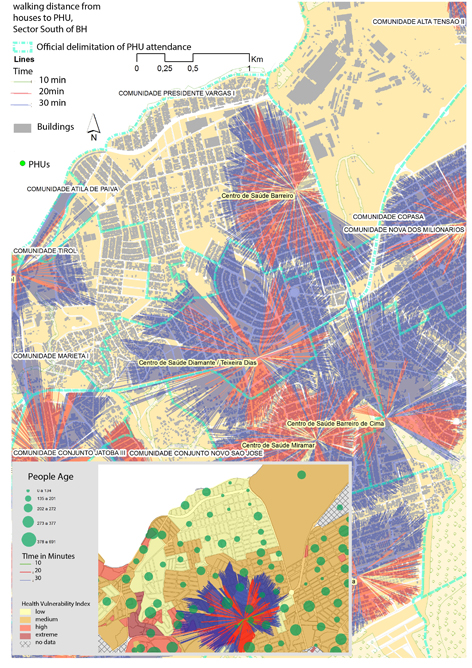
Urban Network Analysis in Health
Abstract
The definition of spatial units of data aggregation is a challenge for research in Urban Health, aiming help visualizing inequities and build an analytical chain that also integrates demographic, socioeconomic, cultural and environmental data. We present a case study comparing the administrative and the spatial divisions obtained by the test of the influence of access to the Primary Health Units (PHU) on the city of Belo Horizonte, elucidating algorithms and concepts used. It is demonstrated the potential of future research on the city's territory, its correlation with Health, regarding the possible the control of spatial conditions to locate and access PUH, waving to the enrichment of the debate on the directions of Urban Health in Brazil and the early stages of a Geodesign.
Keywords
Full Text:
PDFReferences
Alexander, C., Ishikawa, S., & Silverstein, M. (1977). A Pattern Language: Towns, Buildings, Construction. New York: Oxford University Press.
Áreas de Abrangência dos Centros de Saúde | Gestão Compartilhada. (n.d.). Retrieved 4 January 2016, from http://gestaocompartilhada.pbh.gov.br/estrutura-territorial/areas-de-abrangencia-dos-centros-de-saude
Auchincloss, A. H., Gebreab, S. Y., Mair, C., & Roux, A. V. D. (2012). A Review of Spatial Methods in Epidemiology, 2000–2010. Annual Review of Public Health, 33(1), 107–122.
Barcellos, C. de C., & Ramalho, W. M. (2002). Situação atual do geoprocessamento e da análise de dados espaciais em saúde no Brasil. Informática Pública, 221–230.
Barcellos, C. de C., Sabroza, P. C., Peiter, P., & Rojas, L. I. (2002). Organização espacial, saúde e qualidade de vida: análise espacial e uso de indicadores na avaliação de situações de saúde. Informe Epidemiológico Do Sus, 11(3), 129–138.
Bovy. (1973). Reseaux et Espaces Piétonniers. Institut de Technique des Transports.
Daamen, W., Hoogendoorn, S., & Bovy, P. (2005). First-Order Pedestrian Traffic Flow Theory. Transportation Research Record: Journal of the Transportation Research Board, 1934, 43–52.
da República, P. (2011). Decreto n. 7508. Retrieved 2 January 2016, from http://www.planalto.gov.br/ccivil_03/_ato2011-2014/2011/decreto/D7508.htm
Faria, R. M., & Bortolozzi, A. (2009). Espaço, território e saúde: contribuições de Milton Santos para o tema da geografia da saúde no Brasil, Editora UFPR, 17, 31–41. Retrieved from http://www.rets.epsjv.fiocruz.br/sites/default/files/espaco_territoiro_e_saude.pdf
Farias, N., & Buchalla, C. M. (2005). The international classification of functioning, disability and health: concepts, uses and perspectives. Revista Brasileira de Epidemiologia = Brazilian Journal of Epidemiology, 8(2), 187–193.
Gondim, G. M. de M., Monken, M., Rojas, L. I., Barcellos, C., Peiter, P., Navarro, M., & Gracie, R. (2008). O território da saúde: a organização do sistema de saúde e a territorialização. Miranda AC, Barcellos C, Moreira J, Monken M, Organizadores. Território, Ambiente E Saúde. Rio de Janeiro: Fiocruz, 237–255.
Hoogendoorn, S., & Bovy, P. (2002). Normative pedestrian behaviour theory and modelling. Transportation and Traffic Theory. Retrieved from http://www.safetylit.org/citations/index.php?fuseaction=citations.viewdetails&citationIds%5B%5D=citjournalarticle_241769_38
Hoogendoorn, S. P., Bovy, P. H. L., & Daamen, W. (2002). Microscopic pedestrian wayfinding and dynamics modelling. Pedestrian and Evacuation Dynamics, 123, 154.
Leslie, E., Coffee, N., Frank, L., Owen, N., Bauman, A., & Hugo, G. (2007). Walkability of local communities: using geographic information systems to objectively assess relevant environmental attributes. Health & Place, 13(1), 111–122.
Lynch, K. (1997). A imagem da cidade. Tradução Jefferson Luiz Camargo. São Paulo: Martins.
Monken, M., Peiter, P., Barcellos, C., Rojas, L. I., Navarro, M., Gondim, G. M. M., … Others. (2008). O território na saúde: construindo referências para análises em saúde e ambiente. Miranda AC, Barcellos C, Moreira JC, Monken M, (Org.). Território, Ambiente E Saúde. Rio de Janeiro: Fiocruz, 23–41.
Murekatete, R. M., & Bizimana, J. P. (n.d.). A GIS-based Approach for Developing Urban Walkability Indices: The Case of Kigali City, Rwanda. Retrieved from https://www.geotechrwanda2015.com/wp-content/uploads/2015/12/185_Rachel-Murekatete.pdf
Pearse, I. H., & Crocker, L. H. (2013). The Peckham Experiment: A study of the living structure of society. Retrieved from https://books.google.com/books?hl=en&lr=&id=oWGAAAAAQBAJ&oi=fnd&pg=PP1&ots=-DOjcQJnWT&sig=bASXv-E6vldYKD-eZDc4F8Ms2Wo
Perez, G. (2006). Adoção de inovações tecnológicas: Um estudo sobre o uso de sistemas de informação na área de saúde. Universidade de São Paulo. Retrieved from http://www.teses.usp.br/teses/disponiveis/12/12139/tde-15042007-165611/
Pitchon, A. (2013). Índice de Vulnerabilidade da Saúde 2012. Belo Horizonte: Prefeitura de Belo Horizonte.
Silva, L. J. da. (1997). The concept of space in infectious disease epidemiology. Cadernos de Saúde Pública, 13(4), 585–593.
Skiena, S. (1990). Dijkstra’s Algorithm. Implementing Discrete Mathematics: Combinatorics and Graph Theory with Mathematica, Reading, MA: Addison-Wesley, 225–227.
Steinitz, C. (2012). A Framework for Geodesign: Changing Geography by Design. Esri Press.
Temporão, J. G. (2010). PORTARIA No 4.279 DE 30 DE DEZEMBRO DE 2010. Retrieved 1 March 2016, from http://conselho.saude.gov.br/ultimas_noticias/2011/img/07_jan_portaria4279_301210.pdf
Travassos, C., & Martins, M. (2004). Uma revisão sobre os conceitos de acesso e utilização de serviços de saúde. Cadernos de Saúde Pública, 20. https://doi.org/10.1590/S0102-311X2004000800014
Weil, S. (2001). O enraizamento; tradução Maria Leonor Loureiro. Editora Da Universidade Do Sagrado Coração, Bauru.
Wood, D., Kitchin, R., & Blades, M. (2002). The cognition of geographic space. (S. M. Press, Ed.). I. B. Tauris & Co.
World Health Organization. (2008). Relatório Mundial de Saúde 2008 - Cuidados de Saúde Primários, Agora Mais Que Nunca. (World Health Organization, Ed.). World Health Organization.
Refbacks
- There are currently no refbacks.
Copyright (c) 2018 Renato César Ferreira de Souza
DISEGNARECON
ISSN 1828 5961
Registration at L'Aquila Law Court no 3/15 on 29th June, 2015.
Indexed in SCOPUS. Diamond Open Access. All papers are subjected to double blind peer review process by qualified reviewers.
Journal founded by Roberto Mingucci
